The Ringling News
19 December 2022
A Ringling Bronze and the Augusto Grimani
A late 19th/early 20th century bronze statue in the collection of the Ringling Museum of Art is a liberal copy after a renowned ancient marble statue, the so-called Augusto Grimani.

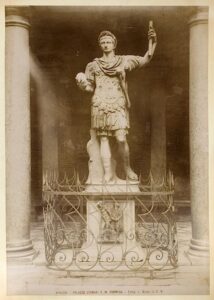
Among the reproduction sculptures purchased by John Ringling in the 1920s and 30s is an over life-size, bronze statue of a Roman general (fig. 1). The figure wears a decorated breastplate with a short skirt terminating just above the knees and a mantle thrown over his left shoulder. In his right hand he holds an orb, a symbol of power, and in his raised left a scepter, assuming a pose associated with the adlocutio, an address delivered to troops. Hanging from his left shoulder by a strap is a dagger and atop his head is wreath of oak leaves.
The Ringling bronze likely copies, in a reduced size and with significant alterations, an ancient Roman marble statue that once stood in the courtyard of the Grimani palace in Venice. The over life-sized Augusto Grimani (fig. 2), as it was sometimes called, was a centerpiece of the Grimani family residence for centuries and a reminder of the priceless collection of antiquities amassed by Cardinal Domenico Grimani (1461-1523) and his nephew Giovanni Grimani (1506-1593), who gave the majority of the pieces to the Venetian state in 1586. The marble, not included in the 16th-century gift, remained in Venice until the early 20th century before being sold, finding its way to a German manor house by the 1930s. In 1952, the statue was obtained by the Universität Rostock, where the arms and legs, the product of a restoration, were removed, and the ancient (unoriginal) head detached.
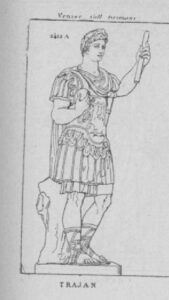
Although textual descriptions of the marble statue prior to the 20th-century restorations abound in travel and art historical literature since the 18th century, images of the piece are much rarer. Apart from the above photograph from ca. 1890, the only other known visual representation of the marble is an illustration that appears in Salomon Reinach’s Répertoire de la statuaire greque et romaine published at the turn of the 20th century (fig. 3).
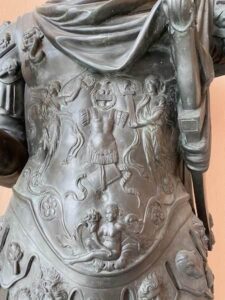
While the Ringling bronze largely captures the pose of the marble figure and features the same attributes, the most convincing point of comparison is in the decoration of the breastplate (figs. 4-5). Both bronze and marble versions show two winged victories – goddesses personifying victory in ancient Roman mythology – each wearing a long tunic (chiton) and adorning a war trophy (tropaion) situated between them. The victory on the left holds a palm branch and wreath – in the bronze version she faces outward but in the marble her back is turned – while the one on the right holds a sheathed sword with both hands. No other ancient marble statue has been found with a decorated breastplate of the same scheme, nor are victories in this context usually depicted carrying sheathed swords. This would suggest that the artist responsible for executing the bronze was familiar with the Grimani marble firsthand. It also makes it unlikely that elements from a number of different ancient marble statues were culled to create a pastiche.
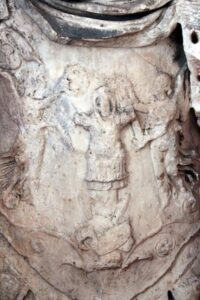
Further similarities between the bronze and marble are to be found in the double row of pteruges, the decorated strips situated below the breastplate and falling at the figure’s waist. In the marble, the figures on either side of the central strap mirror each other (fig. 6). The figures in the bronze do not correspond to those in the marble, nor are they arranged with the same symmetry or rendered in a similar style, but certain elements of the scheme do remain constant. In both versions, heads of mythological figures appear on either side of the central strap; for the marble, two gorgons, and in the case of the bronze, a gorgon and a head of the god Jupiter. The next figures moving outwards show animal heads; ram heads in the marble and wolf heads in the bronze.
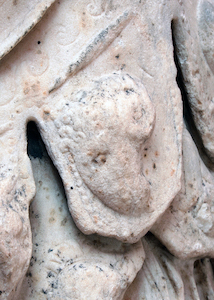

The substitution of wolf for ram in the bronze is clearly an attempt to evoke not just the ancient world, but ancient Rome in particular, the wolf being long associated with the city. Both the central strap, showing the She-wolf suckling the twins Romulus and Remus – the traditional founders of Rome – and the addition on the tropaion of the letters “S.P.Q.R.” – an abbreviated phrase referring to the government of the Roman republic – also emphasize Rome through recognizable symbols. These latter two elements especially are not common to the ancient statues of armor. The bronze then was not intended to be an entirely faithful copy of the marble; neither was it created as a fake or as a convincing replica of an ancient statue. The changes made and liberties taken in the bronze suggest that the piece was meant to be recognizably modern evocation of ancient Roman art and culture.
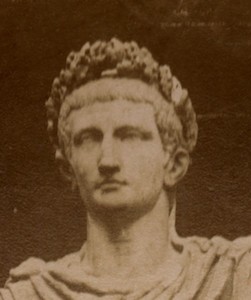
Over the centuries, the person depicted in the Augusto Grimani marble statue has been identified as Julius Caesar, Trajan, Claudius, and as the name suggests, Augustus. It is only recently that the head has been shown to be a portrait of Germanicus (fig 12). The older brother of Claudius and father of Caligula, both eventual emperors of Rome, Germanicus was an accomplished general remembered for his military victories in the province of Germania. In this portrait, Germanicus wears an oak wreath (corona civica), an attribute usually reserved for emperors. Oak wreath besides, the bronze head does not faithfully reproduce the marble one in all aspects. In the bronze, the forehead is shrunken and not as wide, the eyebrows are furrowed, and the chin is more pointed. The hair too in the bronze version appears freer and wavier. If we are to assume that the bronze head does indeed take as its model the marble head, the differences may in part be ascribed to the marble’s former identification as Augustus. It is possible that the artist involved in creating the bronze version incorporated elements from known Augustus portraits, either from other statues or from coins, for the likeness of the head. It is also possible that the head was left generic and was not meant to evoke a specific portrait type.
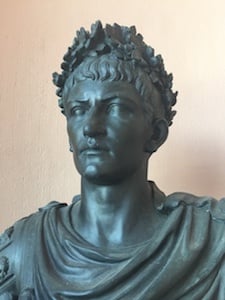
Unlike many of the other pieces on view in the Ringling courtyard, the Roman general (fig 13) was not produced by the Fonderia Chiurazzi in Naples but was likely made by a foundry in Venice – it is probably in Venice where John Ringling purchased it as well, along with other statues and architectural fragments he is known to have acquired there. The circumstances of the bronze’s production and its original context are unknown, although it is possible that it was made around the time the Augusto Grimani was sold, intended as a reminder of the ancient marble sculpture. Whether it was produced for a particular place, perhaps a niche in a Venetian palazzo, or as a piece to be sold from a catalogue of similar reproduction bronzes is also uncertain.
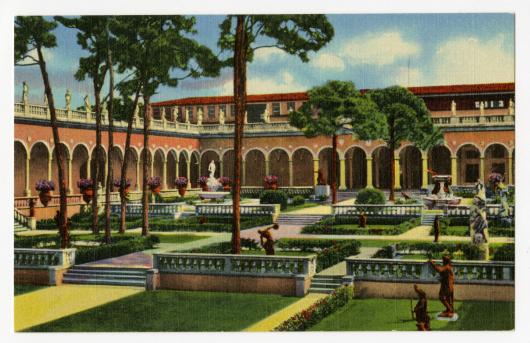
The bronze Roman general, now located in the antelobby of the Museum of Art, was formerly placed in the courtyard alongside other reproduction bronzes and can be seen in the bottom right foreground in this early postcard of the museum (fig. 14).